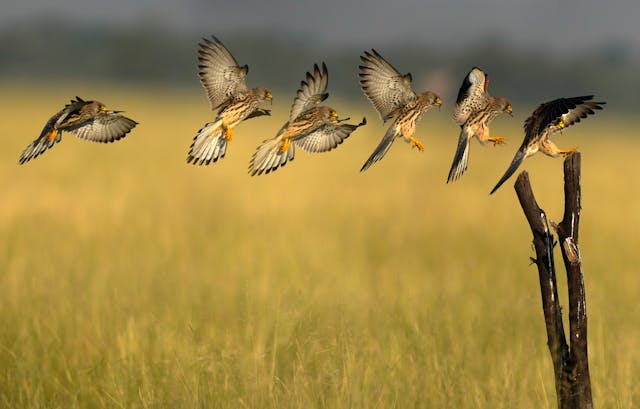
How do birds land? It depends on the size of the bird and whether it is a landing on land, a branch, or water. Generally, they lose as much speed as possible and grab on.
The physics behind the way birds fly is the same as for airplanes. Anything that flies needs lift and thrust, and it must overcome drag. Lift is what pushes the thing into the sky. Birds get this lift by altering the shape and the angle of their wings so that the air flows faster over the top of the wings than it does underneath. This creates lower pressure over the wings than under them and the air moves upwards because air always moves from an area of high pressure to an area of low pressure, which lifts the birds up. Lift can’t work on its own because the air needs to flow over the wings and this is where thrust comes in. With a plane, the thrust comes from the jet engine or the propeller. With a bird the thrust is produced by flapping the winds up and down, which drives the bird forwards and the air over the wings. The last thing is drag, which is the fiction the birds meet from the air they are flying through. To overcome this air resistance, the birds are streamlined as much as possible.
When birds are coming in to land, they need to reduce their lift, their thrust, and their speed so that they don’t get killed. Birds can travel tremendously quickly because of how light and streamlined they are. If they landed without slowing down, they would be smashed, as can be seen from looking at birds that have flown into windows. So, how do birds land? Small birds have a different method to heavy birds. Birds landing on land have a different method to birds landing on water. Birds landing on small perches or branches in a tree have a different method from those landing on a flat surface. Let’s have a look at them.
Small birds tend to have thin and weak legs. They only use them to perch with and they need to be as light as possible so that they can fly. Hummingbirds, for example, don’t really have muscles in their legs, just tendons to make them rigid. Larger birds, on the other hand, have much stronger legs that reflect the different way the two types of birds land. Both large and small birds come in to land in a similar way. The swoop down and flare their wings to reduce lift and increase drag. This removes a lot of the bird’s speed, like an air brake. They tilt their bodies almost vertically and they flap their wings in the opposite direction to slow them down even more. Small birds fly over the area they are going to land on, losing all of their speed, and then they fly slightly up so that their feet touch the ground without any impact. Larger birds come in more like skydivers on a parachute. They come in fast, flare their wings to reduce as much speed as possible, and then rely on their strong legs to take the impact for them.
Birds that land on water have a different method to those that land on land because they can use the water to slow them down. When water birds come in to land, they do the same flaring of the wings to slow them down, but they don’t need to reduce all of their speed. Many of them come in fairly fast and use their webbed feet to almost water ski across the water. As their feet dig in to the water, they create a bow wave, which is a pressure wave in front of where they have landed caused by the water they are pushing forward. This bow wave causes a lot of drag and slows the birds down enough for them to just drop on to the water.
Birds that land on some kind of perch slow themselves down in exactly the same way, but they have to be able to grab the perch. Birds landing on a perch fly in and flare their wings and tails to slow down, then flap in the opposite direction to reduce more speed. They stretch out their legs to make contact with the perch and use their legs to take the impact. If it is a branch, the branch will move, helping with the impact. The bird will lock its talons around the branch to get a grip but, because of the angle it assumed to slow down, it will be almost vertical. It will then shuffle and right itself to get balanced. It seems amazing to us but, of course, if the birds happen to miss, they can fly off and land somewhere else. And this is what I learned today.
Photo by Sachin Nihcas: https://www.pexels.com/photo/timelapse-of-a-bird-landing-on-a-branch-5814467/
Sources
https://www.ncbi.nlm.nih.gov/pmc/articles/PMC6684272
https://earthlife.net/how-do-birds-fly
